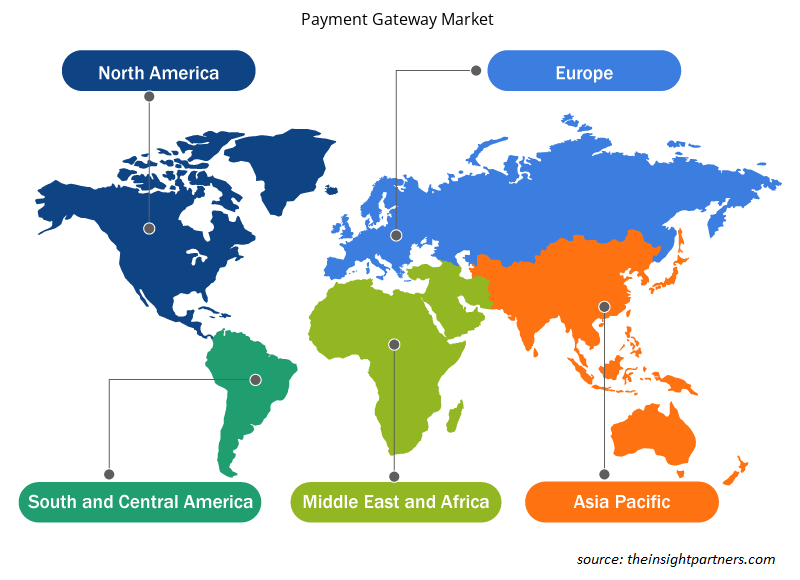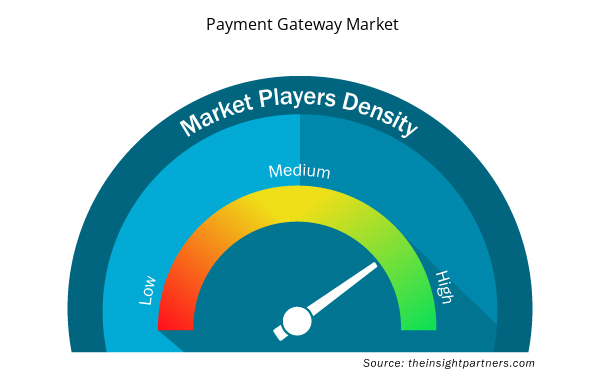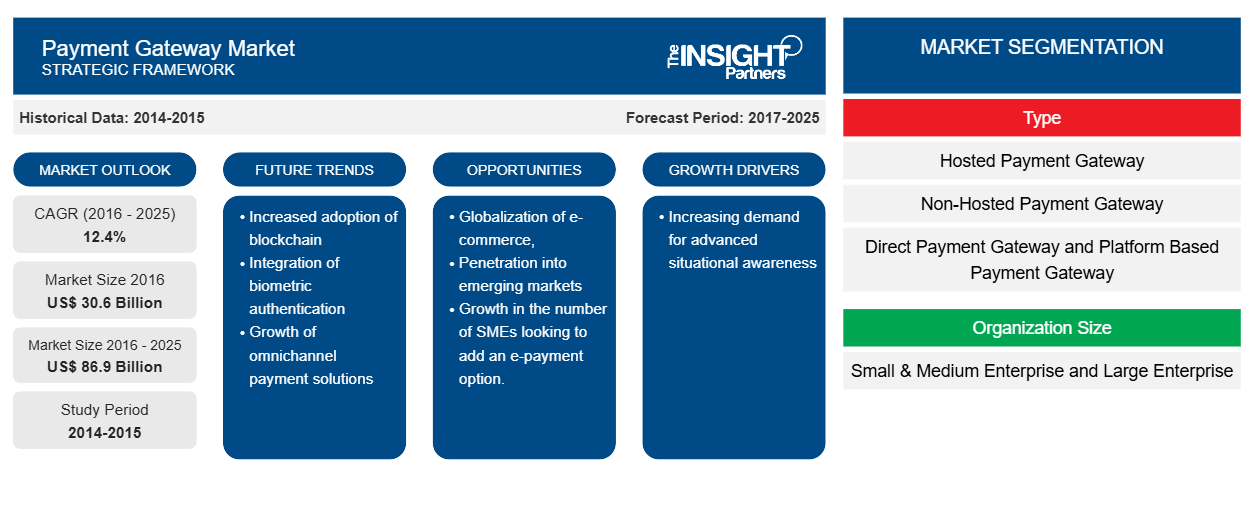Le marché mondial des passerelles de paiement devrait passer de 30,6 milliards de dollars américains en 2016 à 86,9 milliards de dollars américains d'ici 2025, à un TCAC de 12,4 % entre 2017 et 2025.
Les commerçants du monde entier souhaitent ardemment étendre leurs activités au-delà des frontières en adoptant une approche logique, en s'associant aux passerelles de paiement. Grâce à ce partenariat, ces commerçants bénéficient des opportunités créées par la mondialisation du commerce électronique. La majorité des commerçants d'aujourd'hui envisagent une expansion mondiale et souhaitent croître à un rythme plus rapide. Cependant, la dernière chose dont ils auraient besoin dans ce paysage dynamique et concurrentiel est une passerelle de paiement qui freine leur croissance ou les pousse à collaborer avec plusieurs PSP (prestataires de services de paiement) dans différentes régions. Afin de résoudre ces problèmes, le secteur des paiements invite aux avancées technologiques, ouvrant la voie à la croissance du marché des passerelles de paiement
Personnalisez ce rapport en fonction de vos besoins
Vous bénéficierez d'une personnalisation gratuite de n'importe quel rapport, y compris de certaines parties de ce rapport, d'une analyse au niveau des pays, d'un pack de données Excel, ainsi que de superbes offres et réductions pour les start-ups et les universités.
- Obtenez les principales tendances clés du marché de ce rapport.Cet échantillon GRATUIT comprendra une analyse de données, allant des tendances du marché aux estimations et prévisions.
Le rapport se concentre sur une segmentation approfondie de ce marché en fonction du type et de la taille de l'industrie. La segmentation géographique du rapport couvre six grandes régions, notamment l'Amérique du Nord, l'Europe, l'Asie-Pacifique (APAC), le Moyen-Orient et l'Afrique (MEA) et l'Amérique du Sud (SA). Le marché régional a été encore plus divisé par pays respectifs. Par segment de taille d'organisation, les grandes entreprises représentaient la plus grande part du marché des passerelles de paiement en 2016 ; tandis que la région Moyen-Orient et Afrique devrait connaître le TCAC le plus élevé au cours de la période de prévision. Le rapport vise à fournir un aperçu du marché mondial des passerelles de paiement avec une segmentation détaillée du marché. En outre, il analyse le scénario actuel du marché des passerelles de paiement et prévoit le marché jusqu'en 2025. Le rapport couvre la dynamique du marché affectant le marché au cours de la période de prévision. En outre, le rapport analyse le scénario concurrentiel, les tendances géographiques et les opportunités sur les marchés par rapport à toutes les régions géographiques. Le rapport comprend également les profils d'entreprise détaillés des principaux acteurs du marché ainsi que leurs stratégies de marché. Le rapport fournit également une analyse PEST des cinq régions ainsi que l'analyse SWOT pour toutes les entreprises présentées dans le rapport.APAC), Middle East and Africa (MEA) and South America (SA). The regional market has been further bifurcated by respective countries. By organization size segment large enterprises accounted for the largest share of the payment gateway market in 2016; whereas, Middle East & Africa region is expected to grow at the highest CAGR during the forecast period.
Aperçu régional du marché des passerelles de paiement
Les tendances et facteurs régionaux influençant le marché des passerelles de paiement tout au long de la période de prévision ont été expliqués en détail par les analystes d'Insight Partners. Cette section traite également des segments et de la géographie du marché des passerelles de paiement en Amérique du Nord, en Europe, en Asie-Pacifique, au Moyen-Orient et en Afrique, ainsi qu'en Amérique du Sud et en Amérique centrale.

- Obtenez les données régionales spécifiques au marché des passerelles de paiement
Portée du rapport sur le marché des passerelles de paiement
| Attribut de rapport | Détails |
|---|---|
| Taille du marché en 2016 | 30,6 milliards de dollars américains |
| Taille du marché d'ici 2025 | 86,9 milliards de dollars américains |
| Taux de croissance annuel composé mondial (2016-2025) | 12,4% |
| Données historiques | 2014-2015 |
| Période de prévision | 2017-2025 |
| Segments couverts | Par type
|
| Régions et pays couverts | Amérique du Nord
|
| Leaders du marché et profils d'entreprises clés |
|
Densité des acteurs du marché : comprendre son impact sur la dynamique des entreprises
Le marché des passerelles de paiement connaît une croissance rapide, tirée par la demande croissante des utilisateurs finaux en raison de facteurs tels que l'évolution des préférences des consommateurs, les avancées technologiques et une plus grande sensibilisation aux avantages du produit. À mesure que la demande augmente, les entreprises élargissent leurs offres, innovent pour répondre aux besoins des consommateurs et capitalisent sur les tendances émergentes, ce qui alimente davantage la croissance du marché.
La densité des acteurs du marché fait référence à la répartition des entreprises ou des sociétés opérant sur un marché ou un secteur particulier. Elle indique le nombre de concurrents (acteurs du marché) présents sur un marché donné par rapport à sa taille ou à sa valeur marchande totale.
Les principales entreprises opérant sur le marché des passerelles de paiement sont :
- PayPal Holdings, Inc.
- Paiements Amazon, Inc.
- Trading sécurisé à responsabilité limitée
- Cardstream Limitée
- CCBill, LLC
Avis de non-responsabilité : les sociétés répertoriées ci-dessus ne sont pas classées dans un ordre particulier.

- Obtenez un aperçu des principaux acteurs du marché des passerelles de paiement
L'Amérique du Nord est l'une des régions les plus importantes du marché des passerelles de paiement, qui contribuera le plus aux revenus mondiaux en raison des développements technologiques et de l'application considérable des passerelles de paiement dans différents segments d'utilisateurs finaux. Les économies en croissance rapide de la région Asie-Pacifique (APAC) avec un secteur de la construction en croissance significative ouvriront la voie à une adoption croissante et propulseront le marché des passerelles de paiement. La région APAC devrait être en tête du marché avec le TCAC le plus élevé au cours de la période de prévision. Certains des principaux acteurs du marché des passerelles de paiement comprennent PayPal Holdings, Inc., Amazon Payments, Inc., Secure Trading Limited, Cardstream Limited, CCBill, LLC, BitPay, Inc., GoCardless Ltd., Stripe Inc., Due Inc. Merchant Warrior, Authorize.Net et WePay Inc., entre autres.
- Analyse historique (2 ans), année de base, prévision (7 ans) avec TCAC
- Analyse PEST et SWO
- Taille du marché Valeur / Volume - Mondial, Régional, Pays
- Industrie et paysage concurrentiel
- Ensemble de données Excel



Report Coverage
Revenue forecast, Company Analysis, Industry landscape, Growth factors, and Trends

Segment Covered
This text is related
to segments covered.

Regional Scope
North America, Europe, Asia Pacific, Middle East & Africa, South & Central America

Country Scope
This text is related
to country scope.
Trends and growth analysis reports related to Banking, Financial Services, and Insurance : READ MORE..
The List of Companies
1. PayPal Holdings, Inc.
2. Amazon Payments, Inc.
3. Secure Trading Limited
4. Cardstream Limited
5. CCBill, LLC
6. BitPay, Inc.
7. GoCardless Ltd.
8. Stripe Inc.
9. Due Inc.
10. Merchant Warrior
11. Authorize.Net.
12. WePay Inc.
The Insight Partners performs research in 4 major stages: Data Collection & Secondary Research, Primary Research, Data Analysis and Data Triangulation & Final Review.
- Data Collection and Secondary Research:
As a market research and consulting firm operating from a decade, we have published and advised several client across the globe. First step for any study will start with an assessment of currently available data and insights from existing reports. Further, historical and current market information is collected from Investor Presentations, Annual Reports, SEC Filings, etc., and other information related to company’s performance and market positioning are gathered from Paid Databases (Factiva, Hoovers, and Reuters) and various other publications available in public domain.
Several associations trade associates, technical forums, institutes, societies and organization are accessed to gain technical as well as market related insights through their publications such as research papers, blogs and press releases related to the studies are referred to get cues about the market. Further, white papers, journals, magazines, and other news articles published in last 3 years are scrutinized and analyzed to understand the current market trends.
- Primary Research:
The primarily interview analysis comprise of data obtained from industry participants interview and answers to survey questions gathered by in-house primary team.
For primary research, interviews are conducted with industry experts/CEOs/Marketing Managers/VPs/Subject Matter Experts from both demand and supply side to get a 360-degree view of the market. The primary team conducts several interviews based on the complexity of the markets to understand the various market trends and dynamics which makes research more credible and precise.
A typical research interview fulfils the following functions:
- Provides first-hand information on the market size, market trends, growth trends, competitive landscape, and outlook
- Validates and strengthens in-house secondary research findings
- Develops the analysis team’s expertise and market understanding
Primary research involves email interactions and telephone interviews for each market, category, segment, and sub-segment across geographies. The participants who typically take part in such a process include, but are not limited to:
- Industry participants: VPs, business development managers, market intelligence managers and national sales managers
- Outside experts: Valuation experts, research analysts and key opinion leaders specializing in the electronics and semiconductor industry.
Below is the breakup of our primary respondents by company, designation, and region:

Once we receive the confirmation from primary research sources or primary respondents, we finalize the base year market estimation and forecast the data as per the macroeconomic and microeconomic factors assessed during data collection.
- Data Analysis:
Once data is validated through both secondary as well as primary respondents, we finalize the market estimations by hypothesis formulation and factor analysis at regional and country level.
- Macro-Economic Factor Analysis:
We analyse macroeconomic indicators such the gross domestic product (GDP), increase in the demand for goods and services across industries, technological advancement, regional economic growth, governmental policies, the influence of COVID-19, PEST analysis, and other aspects. This analysis aids in setting benchmarks for various nations/regions and approximating market splits. Additionally, the general trend of the aforementioned components aid in determining the market's development possibilities.
- Country Level Data:
Various factors that are especially aligned to the country are taken into account to determine the market size for a certain area and country, including the presence of vendors, such as headquarters and offices, the country's GDP, demand patterns, and industry growth. To comprehend the market dynamics for the nation, a number of growth variables, inhibitors, application areas, and current market trends are researched. The aforementioned elements aid in determining the country's overall market's growth potential.
- Company Profile:
The “Table of Contents” is formulated by listing and analyzing more than 25 - 30 companies operating in the market ecosystem across geographies. However, we profile only 10 companies as a standard practice in our syndicate reports. These 10 companies comprise leading, emerging, and regional players. Nonetheless, our analysis is not restricted to the 10 listed companies, we also analyze other companies present in the market to develop a holistic view and understand the prevailing trends. The “Company Profiles” section in the report covers key facts, business description, products & services, financial information, SWOT analysis, and key developments. The financial information presented is extracted from the annual reports and official documents of the publicly listed companies. Upon collecting the information for the sections of respective companies, we verify them via various primary sources and then compile the data in respective company profiles. The company level information helps us in deriving the base number as well as in forecasting the market size.
- Developing Base Number:
Aggregation of sales statistics (2020-2022) and macro-economic factor, and other secondary and primary research insights are utilized to arrive at base number and related market shares for 2022. The data gaps are identified in this step and relevant market data is analyzed, collected from paid primary interviews or databases. On finalizing the base year market size, forecasts are developed on the basis of macro-economic, industry and market growth factors and company level analysis.
- Data Triangulation and Final Review:
The market findings and base year market size calculations are validated from supply as well as demand side. Demand side validations are based on macro-economic factor analysis and benchmarks for respective regions and countries. In case of supply side validations, revenues of major companies are estimated (in case not available) based on industry benchmark, approximate number of employees, product portfolio, and primary interviews revenues are gathered. Further revenue from target product/service segment is assessed to avoid overshooting of market statistics. In case of heavy deviations between supply and demand side values, all thes steps are repeated to achieve synchronization.
We follow an iterative model, wherein we share our research findings with Subject Matter Experts (SME’s) and Key Opinion Leaders (KOLs) until consensus view of the market is not formulated – this model negates any drastic deviation in the opinions of experts. Only validated and universally acceptable research findings are quoted in our reports.
We have important check points that we use to validate our research findings – which we call – data triangulation, where we validate the information, we generate from secondary sources with primary interviews and then we re-validate with our internal data bases and Subject matter experts. This comprehensive model enables us to deliver high quality, reliable data in shortest possible time.


 Obtenez un échantillon gratuit pour ce rapport
Obtenez un échantillon gratuit pour ce rapport